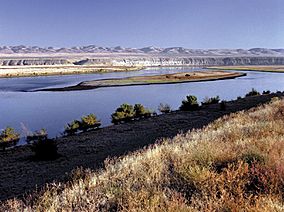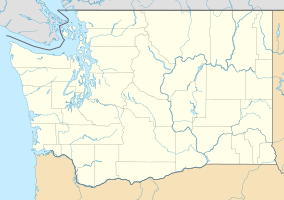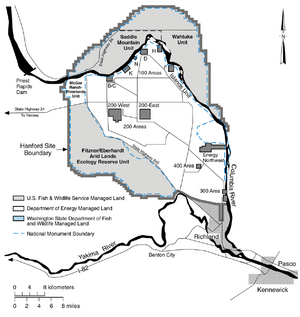Hanford Reach National Monument facts for kids
Quick facts for kids Hanford Reach National Monument |
|
|---|---|
 |
|
| Location | Benton / Grant / Franklin / Adams counties, Washington, USA |
| Nearest city | Richland, WA |
| Area | 194,451 acres (78,692 ha) |
| Created | June 8, 2000 |
| Governing body | U.S. Fish and Wildlife Service U.S. Department of Energy |
| Website | Hanford Reach National Monument |
The Hanford Reach National Monument is a special protected area in the state of Washington, USA. It was created in 2000 by a special order from the President. This monument was mostly made from a security area around the Hanford Nuclear Reservation. Because this land was kept safe and untouched since 1943, it's like a natural time capsule.
The monument gets its name from the Hanford Reach. This is the last part of the Columbia River that flows freely, without dams or tides. It's one of eight National Monuments looked after by the United States Fish and Wildlife Service. Part of the monument is also managed by the United States Department of Energy. In 2000, President Bill Clinton officially created the monument.
Long ago, Native American groups like the Wanapum People, Yakama Nation, Confederated Tribes of the Colville, Confederated Tribes of the Umatilla Reservation, and the Nez Perce used this land. They hunted and gathered resources here.
The area is part of the Columbia Plateau. This land was shaped by ancient lava flows and water. It's a dry, desert-like place called a shrub-steppe. It gets only a little rain each year. Despite this, it's home to many plants and animals. The Hanford Reach is also one of the best places for salmon to lay their eggs in the Northwest. Many rare or endangered animal species live here. Some insect species found here live nowhere else in the world!
Contents
Amazing Animals of Hanford Reach
The Hanford Reach National Monument has two main types of homes for animals: the desert and the river.
River Life: Fish and Their Journeys
The river has islands, rocky areas, gravel beds, and quiet pools. These spots support 43 different kinds of fish. Many Chinook salmon come here to lay their eggs in the fall. Other important fish, like the Upper Columbia River Spring Chinook and Steelhead, use the river to travel. These fish are protected because their numbers are low.
Land Life: Mammals of the Desert
The monument is famous for its elk herd. These elk live in the Arid Lands Ecology Area. The number of elk changes throughout the year. About 150 elk are seen in spring and summer. In the fall, there are usually 350 to 375. The most elk are seen in winter, with an average of 670.
Scientists believe elk have lived in this region for 10,000 years. They disappeared for a while in the mid-1800s. Rocky Mountain elk were brought back in the 1930s. Some also came from the nearby Cascade Mountains during a tough winter in 1978.
The dry desert areas are home to 42 kinds of mammals. Small mice are very common, like the deer mouse. Other mammals living here include coyotes, skunks, beavers, mule deer, bobcats, river otters, minks, cougars, and badgers.
A Look Back in Time: The B Reactor
The Hanford Reach area is home to nine old nuclear reactors. The B Reactor is the most famous one. It was built very quickly during World War II, in just 13 months. This was the world’s first full-size nuclear reactor.
The material made at this reactor was used in the first nuclear explosion. It was also used in the "Fat Man" atomic bomb. This bomb was dropped on Nagasaki, Japan, in 1945. The B Reactor is very important in history. It has been recognized as a National Historic Landmark and other special places.
Visiting the Monument
The monument is usually open from two hours before sunrise to two hours after sunset. Some parts are open to everyone, while others are not.
- Fitzner-Eberhardt Arid Lands Ecology Reserve – This area is for scientific research only. It is closed to the public.
- Columbia River Corridor – The riverbanks and open water are generally open for visitors.
- McGee Ranch and Riverlands – This area is open for public day use.
- Saddle Mountain National Wildlife Refuge – This area is also for research and is closed to the public.
- Vernita Bridge – This spot is open to the public.
- Wahluke Slope – This area is open for visitors.
There was a bill called the Rattlesnake Mountain Public Access Act. This bill wanted to allow people to visit the top of Rattlesnake Mountain. The idea was to help tourism and scientific studies. It passed one part of the government in 2013.
You can also take public tours of some sites in the nearby Hanford Site. This includes the B Reactor, which is part of the Manhattan Project National Historical Park.
Images for kids






